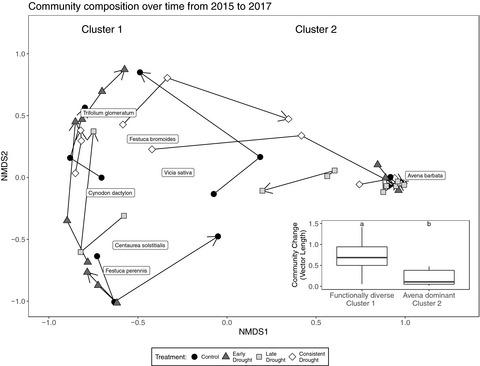Our official English website, www.x-mol.net, welcomes your feedback! (Note: you will need to create a separate account there.)
Intra-annual precipitation effects on annual grassland productivity and phenology are moderated by community responses
Journal of Ecology ( IF 5.5 ) Pub Date : 2021-10-07 , DOI: 10.1111/1365-2745.13792 E. Ashley Shaw 1 , Caitlin T. White 2 , Whendee L. Silver 3 , Katharine N. Suding 2 , Lauren M. Hallett 1, 4
中文翻译:

年内降水对年草地生产力和物候的影响受到群落反应的缓和
更新日期:2021-10-07
Journal of Ecology ( IF 5.5 ) Pub Date : 2021-10-07 , DOI: 10.1111/1365-2745.13792 E. Ashley Shaw 1 , Caitlin T. White 2 , Whendee L. Silver 3 , Katharine N. Suding 2 , Lauren M. Hallett 1, 4
Affiliation

|
- Within ecosystems, intra-annual precipitation patterns—the variability and timing of rainfall—may be a stronger driver of net primary productivity than total annual precipitation. In particular, the amount and timing of precipitation directly affects the amount and timing of plant production, but also indirectly affects productivity via changes to plant community composition. Community response patterns may either buffer or amplify productivity responses to precipitation, as different species respond to different conditions.
- In a semi-arid California grassland, we experimentally tested how plant communities respond to intra-annual precipitation using rainout shelters in which we manipulated drought amount and timing (early season drought, late season drought, continuous drought and ambient precipitation) over 3 years and assessed plant responses: annual net primary productivity (ANPP), phenological timing of peak production and senescence, and community composition.
- Overall, early season and consistent drought treatments had lowest productivity, while late season and consistent drought treatments senesced earlier. Plots with functionally diverse communities shifted community composition and had a significant ANPP response to precipitation treatments. In contrast, communities dominated by a single resource-acquisitive grass species did not change in community composition over time and had no ANPP response to precipitation treatments.
- The timing of production also differed by community, however, where functionally diverse communities remained green longer (particularly under the early season drought treatment) compared to communities dominated by one grass species, which senesced earlier (particularly under the late season drought treatment).
- Synthesis. Our study demonstrates that drought patterns may indirectly drive ANPP via plant community responses in composition and phenology. This suggests that the combination of species composition and vegetation phenology could jointly alter ecosystem-level sensitivity to precipitation seasonality under future climate change. We show that both functional diversity and dominant stability mechanisms are in operation simultaneously, highlighting the need to understand both the context and variation in community structure to predict ANPP responses to intra-annual precipitation.
中文翻译:

年内降水对年草地生产力和物候的影响受到群落反应的缓和
- 在生态系统中,年内降水模式——降雨的可变性和时间——可能比年总降水量更能推动净初级生产力。特别是降水量和降水时间直接影响植物生产的数量和时间,但也通过改变植物群落组成间接影响生产力。由于不同物种对不同条件的反应,群落反应模式可以缓冲或放大对降水的生产力反应。
- 在加利福尼亚半干旱的草原上,我们使用雨棚实验性地测试了植物群落对年内降水的反应,其中我们在 3 年内操纵干旱量和时间(早季干旱、晚季干旱、持续干旱和环境降水),并评估的植物响应:年净初级生产力 (ANPP)、峰值产量和衰老的物候时间以及群落组成。
- 总体而言,早季和持续干旱处理的生产力最低,而晚季和持续干旱处理的生产力较早。具有功能多样化群落的地块改变了群落组成,并对降水处理产生了显着的 ANPP 响应。相比之下,以单一资源获取性草种为主的群落不会随着时间的推移而改变群落组成,并且对降水处理没有 ANPP 响应。
- 然而,生产的时间也因社区而异,与以一种草种为主的社区相比,功能多样化的社区保持绿色的时间更长(特别是在早期干旱处理下),后者衰老较早(特别是在后期干旱处理下)。
- 合成。我们的研究表明,干旱模式可能通过植物群落对组成和物候的反应间接驱动 ANPP。这表明物种组成和植被物候的结合可以共同改变未来气候变化下生态系统水平对降水季节性的敏感性。我们表明,功能多样性和主要稳定性机制同时运行,强调需要了解群落结构的背景和变化,以预测 ANPP 对年内降水的响应。



























 京公网安备 11010802027423号
京公网安备 11010802027423号